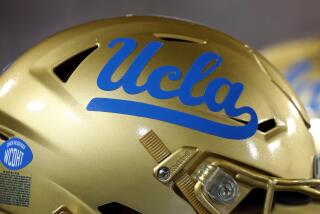UCLA Quake Surprise : Rebuilding: State panel asks school to explain how estimate for repairs increased from $22 million to $630 million.
- Share via
Surprised state lawmakers Friday asked UCLA officials to provide a “very, very detailed” accounting of how damage estimates from the January temblor have risen to $630 million, eclipsing even the toll at earthquake-shattered Cal State Northridge.
The revised damage estimate at the Westwood campus, first made public two weeks ago, is nearly 30 times previous calculations of $22 million.
“We’ve never had a flag from UCLA that suggested the original numbers . . . (were) way out of kilter,” Assemblywoman Marguerite Archie-Hudson (D-Los Angeles) said. “So I was frankly stunned at such a disparity.”
UCLA architect Charles Oakley, appearing at CSUN before the Assembly committee on higher education, told Archie-Hudson that the new figures are based on recent engineering studies that have detected widespread damage and the need for “major structural upgrades” in the university’s massive medical and health sciences complex.
Retrofitting and rebuilding the 9,100-room complex would alone cost $500 million, officials say. Other repairs, including $38 million worth at historic Royce Hall, push the total to $630 million.
That sum far outstrips the expected quake toll at other local higher-education institutions, most notably CSUN, where the temblor cut a swath of destruction that will cost $350 million to fix. A collapsed parking structure on the east side of campus there remains a vivid monument to the quake’s fury.
Damage at the UCLA medical complex, which remains open, is not so visible, Oakley said. Only thorough inspections have uncovered the extent of the problem at the site, where officials say at least seven buildings should receive immediate attention because they provide essential services.
Assemblyman Paul A. Woodruff (R-Moreno Valley) told Oakley that a comprehensive account of how and when the damage was detected, and why the process has taken several months, will be vital if the university hopes to win disaster-relief funds from federal and state agencies.
“This is an enormous amount of money,” Woodruff said. “Our window of opportunity to capture the attention of Congress and the (state) Legislature is going to close.”
Although Oakley said the first inkling that actual damage might exceed initial projections came as long ago as March, no public mention of a new estimate was made until two weeks ago, in an oral report by UCLA Chancellor Charles Young to the UC Board of Regents. In addition to the $630 million, Young favored spending another $500 million to upgrade the medical complex, for a total of more than $1 billion.
Officials expect to have a more exact price tag next month.
Although she did not directly question the validity of the revised figures, Archie-Hudson repeatedly asked Oakley why no warning was given or interim reports issued to lawmakers, who first learned of the increased estimate “in the newspapers.” She said such information could have provided valuable ammunition in the battle to pass Proposition 1A, the $2-billion earthquake-repair bond measure soundly defeated at the polls in June.
“We pushed UCLA very, very hard on the question of its damage. . . . Why is it that this is suddenly such a surprise?”
Oakley said an aggregate figure has been hard to come by as engineers compiled separate reports for different parts of the university, including the medical complex, which boasts more than a dozen buildings.
So far, UCLA has received $1.5 million in federal and state aid for its recovery effort.
Also attending Friday’s hearing were officials from CSUN, Santa Monica College and Southwest College.
CSUN President Blenda J. Wilson told the panel that her university’s fall enrollment dropped by 10% from last year, with about 7% attributable to the earthquake. Although the campus recovery process is well under way, Wilson said she remains concerned whether California will continue to have the resources to supplement federal disaster funds.
The university has so far received about $143 million.
More to Read
Sign up for Essential California
The most important California stories and recommendations in your inbox every morning.
You may occasionally receive promotional content from the Los Angeles Times.











